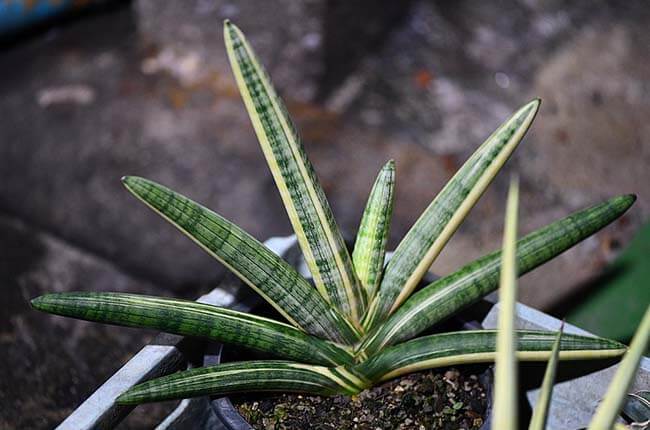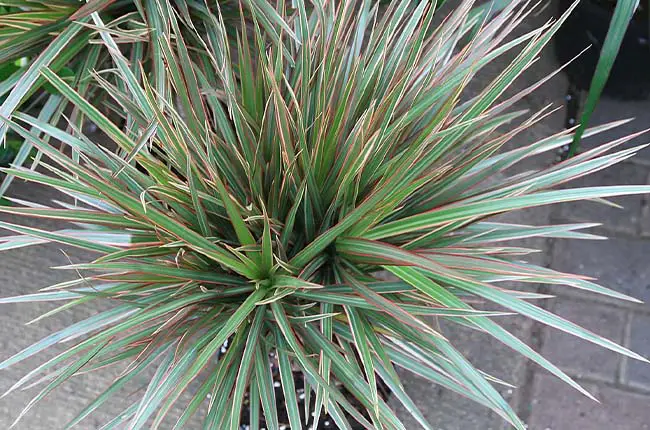The snake plant, with its upright, sword-like leaves, and attractive variegation is an iconic presence in many homes and offices. But, is it actually a succulent?
Although they have different growth habits, many snake plant species are succulents, as they have water-storage tissues, shallow horizontal roots, and carry out CAM photosynthesis, all of which allow them to survive in arid environments.
However, not all snake plant species would be considered succulents.
In this article, we will compare the similarities and differences between snake plants and succulents in terms of scientific classification, water-storage structures, growth habits, and plant care.
What are snake plants?
Snake plants are evergreen perennials native to tropical West Africa, southern Asia through to northern Australia, and a couple of species extend into tropical Central America.
They are popular houseplants in temperate regions due to their foliage most often with attractive variegation and easy plant care.
They are stemless plants with sharp-pointed sword-like leaves that are deep green with some random silver/grey horizontal bands.
In the wild, the plants can reach up to 6 feet (183 cm) in height, and produce a single flower stalk with several small white-green fragrant flowers in spring. However, indoor snake plants rarely produce flowers and do not grow as tall as those in the wild.
Classification
The common name “snake plant” typically refers to Dracaena trifasciata (formerly Sansevieria trifasciata).
But, it is also referred to more than 70 species recognized within the genus Dracaena (formerly Sansevieria), for example:
- Sansevieria cylindrica (Dracaena angolensis): The cylindrica snake plant is known for its round tubular leaves which are about 1-2 inches (2.5-5 cm) in diameter. The leaves are typically dark green with variegated horizontal banding or mottling.
- Whale fin snake plant (Dracaena masoniana): It is known for its large singular leaves that grow straight up from the ground. The leaves are typically dark green with lighter green spots and reddish-brown hues on the edges. It can grow quite large – up to 4 feet (around 1.2 meters) tall and around 10 inches (25 cm) wide.

(Tris T7, CC BY 3.0, via Wikimedia Commons)
Snake plants can also be referred to as the cultivars of a snake plant species. For example, Dracaena trifasciata has numerous cultivars including ‘Laurentii’, ‘Moonshine’, ‘Black Gold’, etc. Here are some popular snake plant cultivars:
- Laurentii (Dracaena trifasciata ‘Laurentii’): The Laurentii snake plant variety is known for its characteristic bright yellow margins.
- Twisted Sister (Dracaena trifasciata ‘Twisted Sister’): The twisted sister snake plant has curling leaves with yellow margins and are widespread, rather than upstanding like the regular snake plant.
- Moonshine (Dracaena trifasciata ‘Moonshine’): Moonshine has broader and shorter leaves which are silvery-gray rather than deep green.
- Golden Flame (Dracaena trifasciata ‘Golden Flame’): This snake plant has a similar shape and size as the regular snake plant, but the leaves have yellow margins and vertical yellow stripes.
- Black Coral (Dracaena trifasciata ‘Black Coral’): This variety has very dark, near-black leaves with starkly contrasting silvery horizontal bands. It can grow up to 3 feet (90 cm) indoors.
On the other hand, “succulent” is not a specific taxonomic classification but a general description of plants that have adapted to arid conditions by developing tissues that store water. Succulents can be found in over 60 plant families, including:
- Aizoaceae: Also known as the ice plant family, this family includes many popular succulent genera like Lithops (living stones) and Fenestraria (baby toes).
- Cactaceae: The cactus family is one of the most recognizable succulent families, with genera ranging from the large and columnar like Carnegiea (which includes the Saguaro cactus) to the small and round like Mammillaria.
- Crassulaceae: This family includes many common houseplant succulents, including Crassula (which includes the jade plant), Echeveria, and Sedum.
Many snake plant species are classified as “succulents” because of their thick, fleshy leaves that store water.
However, not all snake plants are considered succulents. One example is Dracaena marginata, also known as the Madagascar Dragon Tree or Red-Edged Dracaena. It’s characterized by slender stems and flexible, narrow leaves that are often a dark, glossy green with red or purple edges. Unlike the succulent Dracaena species, Dracaena marginata doesn’t have thick, fleshy leaves for storing water which is characteristic of succulents.

(Photo by David J. Stang, CC BY-SA 4.0, via Wikimedia Commons)
Water-storage tissues
Both the snake plant and succulent store water in the stem and leaves.
The water storage tissue called hydrenchyma is made of specialized parenchyma cells that have large vacuoles for storing water.
For example, the aloe vera (Aloe barbadensis) has thick lance-shaped green leaves to hold water; The jelly bean plant (Sedum robrotinctum) has chubby bean-shaped leaves; And the Saguaro cactus (Carnegiea gigantea) has thick stems and branches which can hold between 30 to 40 gallons of water each.
The water storage tissues are an important adaptation for surviving infrequent rains and extreme arid environments.
Appearance
Snake plants typically produce erect, sword-like leaves growing from rhizomes underground, thus appearing as if they are stemless. Cultivated varieties can have twisted (but still rigid) leaves in a rosette arrangement. In either case, the leaves are deep green with horizontal gray stripes. Some cultivars may also have an additional yellow variegation at the margins and center.
In contrast, succulents have a wide range of growth habits. Some are small and low-growing, while others are shrubby or even tree-like (arborescent). Some succulents spread with creeping stems while others grow in clumps. This variation is a reflection of the diverse array of plant families and genera that include succulent species.
CAM photosynthesis
Snake plants and many succulents carry out CAM (Crassulacean Acid Metabolism) photosynthesis, which is a water-conserving method where the plant keeps its stomata closed during the hot dry day and open them at night for gas exchange to reduce moisture loss.
Shallow horizontal roots
Both the snake plant and many succulents, especially those adapted to desert environments, have developed shallow, extensive root systems to maximize water absorption during rare rainfalls to quickly absorb the light rainfall before water evaporates.
These roots often spread out horizontally just beneath the soil surface. They typically range from 1 to 4 inches (about 2.5 to 10 cm) deep, but this can vary greatly due to plant size and growing conditions.
Plant care
Snake plants and succulents have similar requirements in terms of light, water, feeding, soil type, and temperature.
- Water requirement: Since they store water in the leaves, both the snake pant and succulents do not need to be watered frequently like other plants. They should be watered thoroughly and only when the soil is bone-dry.
- Pots and soil type: Because of their shallow roots, both succulents and snake plants thrive in shallow clay pots that do not retain much water. The soil should be gritty and quick draining, to ensure that the roots do not remain moist for long. Large pots and substrates that hold onto too much moisture can lead to root rot.
- Light requirement: Light is important to succulents, and most require at least 6 hours of sunlight daily. Snake plants have similar requirements, but they can also tolerate some shade but too much shade will result in stunted growth.
- Temperature: the ideal temperature for both snake plants and succulents is between 70 to 90 F (21 to 32 C).
- Humidity: Snake plants and succulents in general, prefer humidity levels around 40 to 50%, but can tolerate slightly higher or lower than this range.
- Fertilizer: Snake plants like other succulents do not require much fertilizer. A weak dosage of fertilizer once in the spring is sufficient.
Related
Which Succulents Have Shallow and Deep Roots? (Explained)
How To Find Plants with Stable Variegation: 7 Examples
4 Ways To Induce Variegation In Plants (Explained)
14 Plants With Unstable Variegation (And How To Keep It)
- Keiki Paste vs Rooting Hormone:What’s the difference? - February 4, 2024
- Top 10 Orchid Fertilizers: A Comprehensive Review (2024) - February 2, 2024
- Top 8 Soil Inoculants For Stronger Plants (2024) - February 1, 2024
